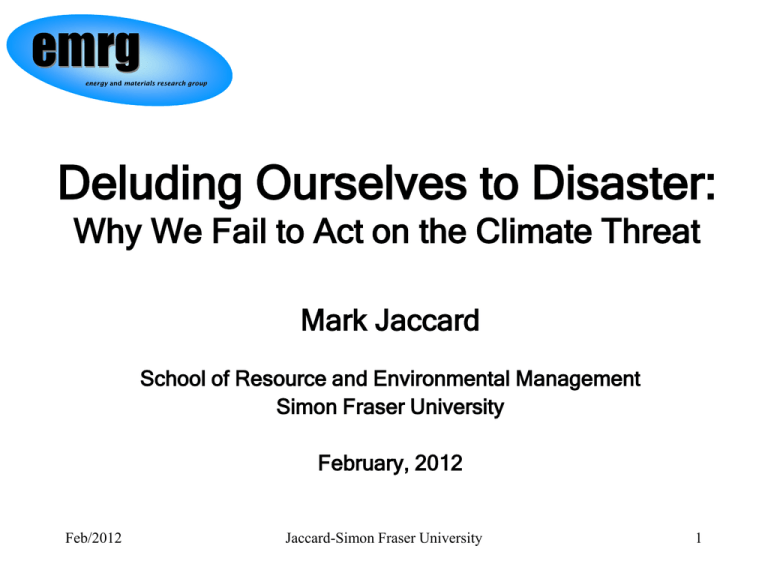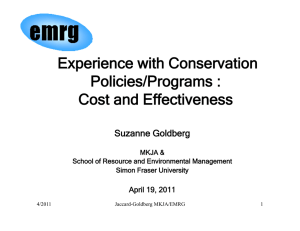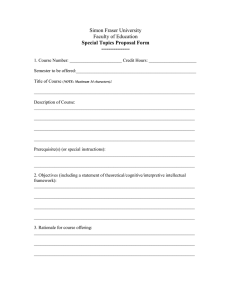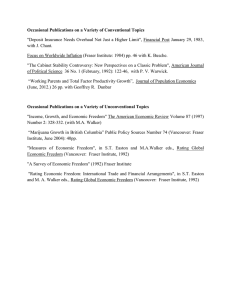emrg Deluding Ourselves to Disaster: Mark Jaccard
advertisement

emrg energy and materials research group Deluding Ourselves to Disaster: Why We Fail to Act on the Climate Threat Mark Jaccard School of Resource and Environmental Management Simon Fraser University February, 2012 Feb/2012 Jaccard-Simon Fraser University 1 emrg energy and materials research group Outline The climate change threat and our motives for action The details – emissions, concentrations, temperature, impacts Political promises and their implications for energy & emissions Reasons for the multi-decade failure to act, with focus on delusions Personal and collective strategies for effective climate action Feb/2012 Jaccard-Simon Fraser University 2 emrg energy and materials research group Today Tipping point Feb/2012 Jaccard-Simon Fraser University 3 emrg energy and materials research group Values and acting on the climate threat Self-interest – each of us is inside the test tube of a global experiment that scientists say will have catastrophic impacts on us and our offspring. Responsibility for the biosphere – climate change to cause mass extinctions. Responsibility for other humans – rich countries developed by burning fossil fuels, yet initial impacts will be concentrated in poorer countries. Feb/2012 Jaccard-Simon Fraser University 4 emrg energy and materials research group Responsibility by country in cumulative carbon emissions Patz JA, Gibbs HK, Foley JA, Rogers JV, Smith KR, 2007, Climate change and global health: Quantifying a growing ethical crisis, EcoHealth 4(4): 397–405, 2007. Feb/2012 Jaccard-Simon Fraser University 5 emrg energy and materials research group Feb/2012 Climate-related mortality per million people by 2000 Jaccard-Simon Fraser University 6 emrg energy and materials research group Prescription vs prediction While different values lead to different “prescriptions” for how humans ought to act, what might we realistically hope for, given human tendency to: • hold beliefs that favor one’s interests (self-interest bias), • overlook inconvenient logical connections (cognitive dissonance), • think uncritically (susceptibility to misinformation), and • have institutions incapable of long-term collective pursuits. Need strategies that motivate successful national and global action, in spite of these characteristics of individuals and society – exercise in “prediction,” not wishful thinking. Feb/2012 Jaccard-Simon Fraser University 7 emrg Details: emissions, concentrations, temperatures, impacts to 2100 + energy and materials research group Source of confusion CO2 e = CO2 + methane + nitrous oxide + others Level CO2 (ppm) CO2 e (ppm) Likely tempΔ Pre-1750 280 ? 0C 2010 level 390 460 2.2 C (1.2 in 2010) critical level 350 450 2C Stern target current path 450 ≈700 550 ≈800 -> 4 –36C? C Realistically? 550 650 -> 3 C + ? 350.org Scientists contemplate 4C beyond 2100 www.eci.ox.ac.uk/4degrees Sources: IPCC, Energy Modeling Forum, Anderson & Bows, 2009 Feb/2012 Jaccard-Simon Fraser University 8 emrg energy and materials research group Past sea level vs temperature Long-term effect Feb/2012 Source: Archer Jaccard-Simon Fraser University 9 emrg energy and materials research group Political promises & implications Political leaders promise at Copenhagen in 2009 not to allow temperature increase to exceed 2°C. Political leaders of most rich countries promise to reduce emissions 80% by 2050. Canada (Harper) promises 65%. But even to achieve 550 ppm CO2e, global emissions must fall at least 50% by 2050 (if rich fall 80%, poor must fall 30%). Feb/2012 Jaccard-Simon Fraser University 10 emrg Emissions trajectory for 550 CO2e energy and materials research group Falling global emissions before 2020 550 CO2e target needs 50% global drop by 2050 Source: Bowan & Ranger, 2009 Feb/2012 Jaccard-Simon Fraser University 11 emrg Current world energy-CO2 path energy and materials research group 500 Renewable CO2-free =15% Primary Energy (EJ) 400 Commercial aviation 300 200 100 Microchip Nuclear energy Television Steam engine Electric motor Gasoline engine Next 50 years? Nuclear Gas CO2 emitting = 85% Oil Vacuum tube Coal 0 1850 Feb/2012 Biomass 1900 1950 Jaccard-Simon Fraser University 2000 12 emrg energy and materials research group CO2–free energy share to achieve 550 CO2e 50% reduction from growing system requires 80% CO2-free globally Only possible if all energy investment is CO2-free from today 15% in 2010 Source: Nakicenovic Feb/2012 50% in 2030 80% in 2050 CO2-free energy share = biomass + other renewables + nuclear + fossil fuels with CCS Jaccard-Simon Fraser University 13 emrg energy and materials research group CO2-free share by sector to achieve 550 ppm CO2e Electricity generation - 90% CO2-free by 2050 (renewables, fossil fuels with carbon capture and storage, nuclear). Buildings - 85% CO2-free by 2050 (heat pumps, passive solar, biofuels, photovoltaics, solar hot water) Vehicles - 80% CO2-free by 2050 (electric, biofuel, hydrogen) Feb/2012 Jaccard-Simon Fraser University 14 emrg energy and materials research group Truth-testing our politicians: the case of Canada Canadian government aggressively promotes tar sands expansion, including Keystone and Gateway pipelines. Is the government’s action consistent with its 2050 promise? Independent research consistently says no. E.g. MIT researchers model Canada’s 2050 target and the global path to 550 CO2e – assess implications for tar sands over 40 years. Feb/2012 Jaccard-Simon Fraser University 15 emrg energy and materials research group Feb/2012 Achieving 550 ppm CO2e plus Harper’s promise: MIT study Jaccard-Simon Fraser University 16 emrg energy and materials research group Tar sands under 50% global CO2e reduction to 2050 2010-2050, higher cost / higher emission oil unprofitable under reduced oil demand and CO2e reduction policies (regulations or charge of $100 /tCO2 by 2020, $200 by 2035). Investments today in tar sands production and pipelines are inconsistent with Harper’s promise to reduce emissions 65% by 2050 and with global achievement of 550 ppm CO2e. The main reason for the demise of the oil sands industry with global CO2 policy is that the demand for oil worldwide drops substantially. … it can be met with conventional oil resources that entail less CO2 emissions in the production process.” - Chan et al., MIT, 2010 Feb/2012 Jaccard-Simon Fraser University 17 emrg energy and materials research group Summary: obvious conclusions from independent studies World not on the path to 450 CO2e (=350 CO2). World not on the path to 550 CO2e. Canada not on a path to 65% reduction by 2050 (tar sands + pipeline investments = government not telling truth). Canada / world locking on to path to 800 CO2e by 2100. This path has catastrophic damages from extreme weather, disease, ecosystem destruction, sea level rise and ocean acidification – to be experienced by people who are alive today. You, and especially your children. Feb/2012 Jaccard-Simon Fraser University 18 emrg energy and materials research group Understanding the failure to act We’ve had past “successes” addressing environmental threats – acid emissions, smog creating emissions, ozone-depleting emissions, lead emissions, etc. Yet climate policy failure now approaching three decades Do climate-altering emissions present a more difficult problem? Feb/2012 Jaccard-Simon Fraser University 19 emrg energy and materials research group Specific challenges of climate issue Global public good - individual initiatives of little value – need compliance enforcement mechanism Delayed effects – must act now to prevent future impacts, but human decision-making often myopic (individual, market, politics). Who pays - perceptions of equity aligned with self-interest (polluter pays vs equal payment per capita or GDP vs historical responsibility) Uncertainty – complex earth-atmosphere system causes uncertainties, even though catastrophic outcome is virtually certain. High starting costs – total transformation costs small, but high initial costs and risks to begin shift to CO2-free (renewables, CCS, nuclear) Feb/2012 Jaccard-Simon Fraser University 20 emrg energy and materials research group Critical role of US Bad luck (given global importance of US) – – – Election of George W. Bush in 2000 and 2004 (gave time for fossil fuel and anti-government lobbies to organize and campaign) Delay allows opponents time to exploit flaws in human thinking in characterizing the climate risk and the costs of action Issue falls victim to increasingly polarized US political system Survey question: “Do humans affect the climate by burning fossil fuels?” 1997 Yes - 52% of Democrats and 48% of Republicans 2008 Yes - 76% of Democrats and 42% of Republicans 2012 Today? Feb/2012 Jaccard-Simon Fraser University 21 emrg energy and materials research group Self-serving bias and efforts to discredit climate science & policy “It is difficult to get a man to understand something when his salary depends on his not understanding it.” - Upton Sinclair Exploiting anti-science bias – easier to convince people to disbelieve science when its conclusions conflict with their self-interest. Exploiting anti-establishment bias – easier to convince people to disbelieve science by portraying IPCC as the establishment, which, conspiracy-like, forces all climate scientists to conform. Exploiting anti-government bias – easier to convince people to resist climate policy if portrayed as excessive regulation, higher taxes, and “social engineering.” Greenwashing campaigns – creating alternative images to the reality of GHG pollution – “clean coal,” “clean natural gas,” “ethical oil” Feb/2012 Jaccard-Simon Fraser University 22 emrg energy and materials research group Response: being realistic about humans If we don’t take these characteristics into account, we will fail to motivate effective individual and political action on climate change. Ironically, there are delusions associated both with those who don’t want to act on climate and those who do. Feb/2012 Jaccard-Simon Fraser University 23 emrg Response: communicating science and risk energy and materials research group Feb/2012 Jaccard-Simon Fraser University 24 emrg energy and materials research group Response: confronting the “what about the Chinese” argument Question for high school students. Figure out how the international community achieves collective action on a public good when: • Some countries are much richer than others • The rich countries have much higher cumulative emissions • Poor countries want rich to pay all their costs • The rich countries can use subsidies and trade threats to get global compliance Always the same answer. • Rich countries go first with cutting their emissions thus lowering the costs of CO2-free technologies and fuels • Soon they provide subsidies and apply trade measures (if necessary) to ensure universal compliance with global effort Feb/2012 Jaccard-Simon Fraser University 25 emrg energy and materials research group Response: confronting the “our emissions are small” argument Canada is responsible for 2% of global CO2 emissions. In World War II, Canada was responsible for 2% of the Allied effort that defeated Germany and Japan. Feb/2012 Jaccard-Simon Fraser University 26 emrg energy and materials research group Response: confronting the “we need the economic growth & jobs” argument Question for elementary school students. What happens when your job creation strategy destroys the planet? Low carbon growth will be more energy-secure, cleaner, safer, quieter and more biodiverse. Low-carbon growth is the future growth story. High-carbon growth, on the other hand, will destroy itself. Economic growth has been used often to justify harm. – Nicholas Stern Feb/2012 Jaccard-Simon Fraser University 27 emrg energy and materials research group Response: confronting the selfinterest bias of fossil fuel regions No use of fossil fuels extremely difficult (impossible?) burning fossil fuels Feb/2012 difficult fossil fuels with CCS CCS = carbon capture & storage Jaccard-Simon Fraser University 28 emrg energy and materials research group Response: confronting the “we don’t need climate policy” argument Corporate social responsibility as solution – but businesses ultimately compete on the basis of bottom-line and fossil fuels are cheap Green consumerism as solution – but virtually all human expenditures of income involve energy use at some stage Energy efficiency is cheap as solution – but usually it is more expensive and inconvenient than simply burning fossil fuels Peak oil and high energy prices as solution – but the earth’s crust has a scary plentitude of fossil fuels and humans keep innovating to find and extract more Carbon neutrality as solution – but most carbon offsets pay people for reductions they would have made and thus don’t divert from our trajectory of rising emissions – “false sense of progress” Feb/2012 Jaccard-Simon Fraser University 29 emrg energy and materials research group A scary plentitude of fossil fuels: Global Energy Assessment Historical production through 2009 Production 2009 Reserves Resources Additional occurrences Conventional oil Unconventional oil [EJ] 6 647 607 [EJ] 166.7 23.1 [EJ] 4 900 – 7 610 3 750 – 5 600 [EJ] 4 170 – 6 150 11 280 – 14 800 [EJ] n.a. > 40 000 Conventional gas Unconventional gas 3 467 158 112.7 12.0 5 000 – 7 100 20 100 – 67 100 7 200 – 8 900 40 200 – 121 900 n.a. > 1 000 000 Coal 7 269 152.7 17 300 – 21 000 291 000 – 435 000 n.a. Conventional uraniumb Unconventional uranium 1 333 25.6 2 339 7 420 n.a. 4 100 2 600 000 n.a. 1 Feb/2012 Jaccard-Simon Fraser University 30 emrg Energy consumption and new devices (US data) energy and materials research group Electricity consumption per household (kWh) 4000 3000 Computer Imaging Telephone 2000 15 energy using devices Air conditioning and refrigeration Television 1000 Personal care Thermal Labour saving 0 1976 Feb/2012 45 energy using devices Steve Groves, SFU – 2009 Audio 1981 1986 1991 1996 Year Jaccard-Simon Fraser University 2001 2006 31 emrg energy and materials research group Response: confronting the “climate policy can’t work” argument Information and subsidies do not work – 20 years of evidence. Economists insist on emissions pricing for economic efficiency (carbon tax and/or cap-and-trade), but this is difficult politically. Yet successful environmental policies have been mostly regulations that require phase-out of undesired technologies and fuels (acid rain, smog, lead, ozone-depleting emissions, etc.). Design regulations (and pricing) to be efficient – e.g., BC’s carbon tax and BC’s zero-emission electricity policy. Feb/2012 Jaccard-Simon Fraser University 32 emrg energy and materials research group Response: if government won’t act (and perhaps is lying) What is your moral duty as a citizen if independent evidence consistently shows your government is not telling the truth and that the implications are disastrous? Public relations / social networking campaigns / boycotts – focus on popular culture, Hollywood, etc. Legal action – 100 US coal plants delayed or postponed in past 5 years. Non-violent civil actions (350.org, Greenpeace, VTACC) • • • • Feb/2012 Sit-ins at government chambers and offices Pickets at elected officials’ constituency offices Blockades of fossil fuel facilities – coal plants, oil pipelines, oil sands Blockades of downtown parking lots to hinder high-emission vehicles Jaccard-Simon Fraser University 33 emrg energy and materials research group Feb/2012 Response: civil action if necessary – 350.org, Washington, 2011 Jaccard-Simon Fraser University 34




